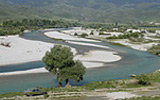Austria
Austria’s Landscape, Climate and Water Flow
Austria is a mountainous country with 62% comprising mountainous terrain; the remainder is hilly, with low-lying plains to the East. Alpine geological formations run in a predominantly west-east direction, with water draining north to the Danube and south to the Drava/Drau. The gradient of the Austrian Danube is circa 0.4 ‰, much steeper than in Lower Bavaria and the Hungarian Plain. Austria’s continental climate displays high precipitation rates in Alpine areas (up to 3500mm/annum), whereas <500mm/annum is recorded in the dry Northeast. Average precipitation within the Basin is 1090mm/annum in Austria, with an evapotranspiration rate of c.500 mm/annum and an outflow via the Danube and southern/eastern tributaries of 575mm/annum. Consequently Austria contributes 46.3 km³/annum (< 25%) to the direct flow of the Danube.
Did You Know?
Austria has signed the Danube River Protection Convention already in 1994. Its capital Vienna is the location for the ICPDR Secretariat.
Natural highlights include:
the Wachau Valley – a UNESCO World Heritage Site and outstanding example of a fluvial and cultural landscape bordered by mountains; the Donau-Auen National Park - a protected floodplain area with a still relatively intact ecosystem linking Vienna and Bratislava; the Thayatal National Park - an impressive protected area on the River Thaya/Dyje (Austria - Czech border); and Neusiedler See (Fertő-tó in Hungary) – also a UNESCO World Heritage Site consisting of a large, shallow lake, more than half of which is dominated by reeds.
Human uses
Austria’s major rivers and valleys are heavily utilised: more than 40% of Austria’s Danube Basin is used for agriculture, settlements and infrastructure; most of the remainder is too mountainous for such activities. With all available valley floor space developed, there has been a marked impact on rivers. Due to this and steep river gradients resulting in low water storage capacity in the inundation zones, Austria has a long history of dealing with floods and landslides. Major river systems are also utilised for hydroelectric power generation (an important power source for the country); navigation (the Danube is a major international commercial waterway); as receiving waters for effluents and drinking water supply (nearly 100% of Austria’s domestic supply stems from alluvial and karstic ground water bodies).
Pollution
With 86% of Austrians living in houses with main sewerage. The remaining 14%, located mainly in rural areas, are the focus for future wastewater management resources.
Treatment of point source nutrient discharges go beyond the requirements of the EU Urban Waste Water Directive and estimates for such discharges leaving Austria via rivers to the Black Sea are 15.2 kt/a for reactive nitrogen, and 1.2 kt/a for phosphorus. The situation for diffuse discharges is less ideal, with past data for reactive nitrogen showing elevated, although declining, concentrations in groundwater. Concentrations are high where agricultural activities take place above groundwater bodies with a limited recharge rate. However, it is the low concentrations from Alpine areas that are more important in terms of their relative share. Due to the large run-off from Austria, background fluxes are also elevated in relative terms when compared with other states. Estimates of the diffuse discharge of reactive nitrogen leaving Austria to the Black Sea is 64.3 kt/a. Regarding phosphorus, the share of reactive phosphorus from deposition is small. Estimates of the diffuse discharge of phosphorus leaving Austria to the Black Sea is 4.7 kt/a.
With regard to Priority Substances, a large set of emission ordinances specifies the requirements for industrial wastewater discharges to waters and public sewerage systems. The effective implementation of emission based requirements for industrial effluents is primarily characterised by internal (“front of pipe”) measures, such as prevention of raw material losses or water reuse added by reasonable “end of pipe” techniques of wastewater treatment.
For detailed information and statistics on the impact of pollution and hydro-morphological alterations to the Danube system, download the fact sheet below.
Disclaimer
The information contained in the ICPDR website is intended to enhance public access to information about the ICPDR and the Danube River. The information is correct to the best of the knowledge of the ICPDR Secretariat. If errors are brought to our attention we will try to correct them.
The ICPDR, expert group members, nor other parties involved in preparation of information contained on this website cannot, however, be held responsible for the correctness and validity of the data and information provided, nor accept responsibility or liability for damages or losses arising directly or indirectly from the use of the information conveyed therein.
Only those documents clearly marked ICPDR documents reflect the position of the ICPDR.
Any links to other websites are provided for your convenience only. The ICPDR does not accept any responsibility for the accuracy, availability, or appropriateness to the user's purposes, of any information or services on any other website.
When using the information and material provided on this website, credit should be given to the ICPDR.

